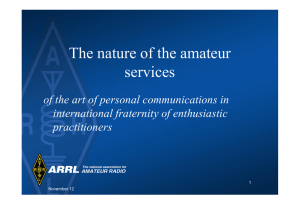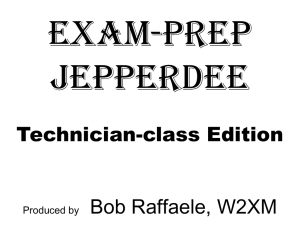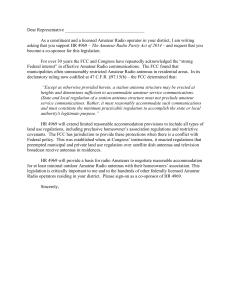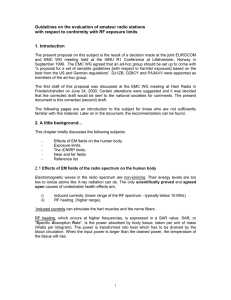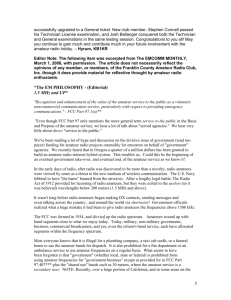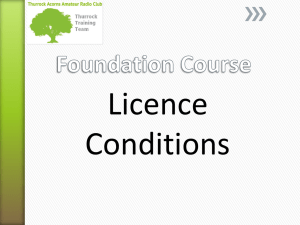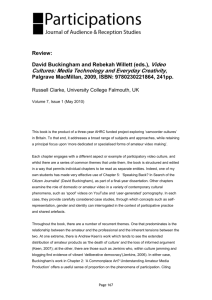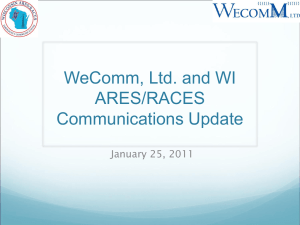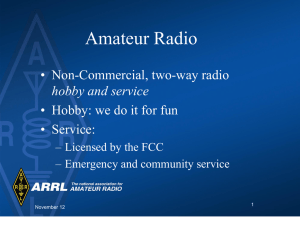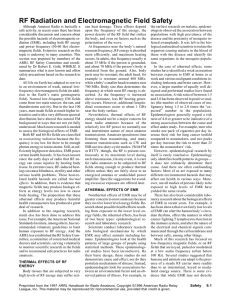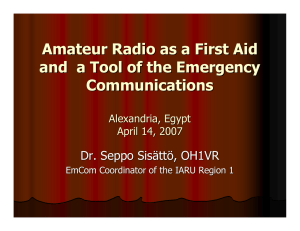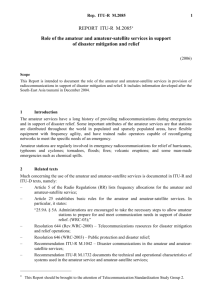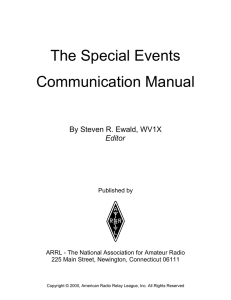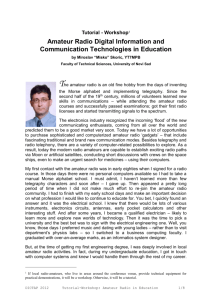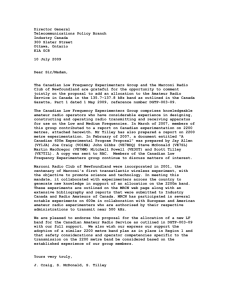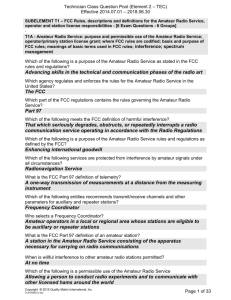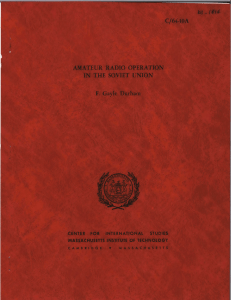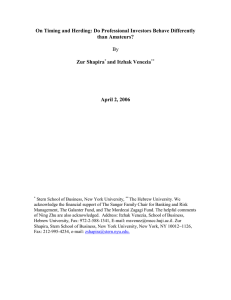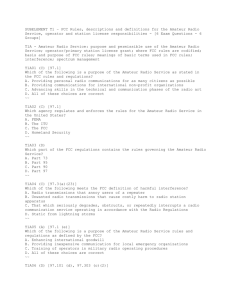025 Emergency Communications - The Australian - iaru
advertisement
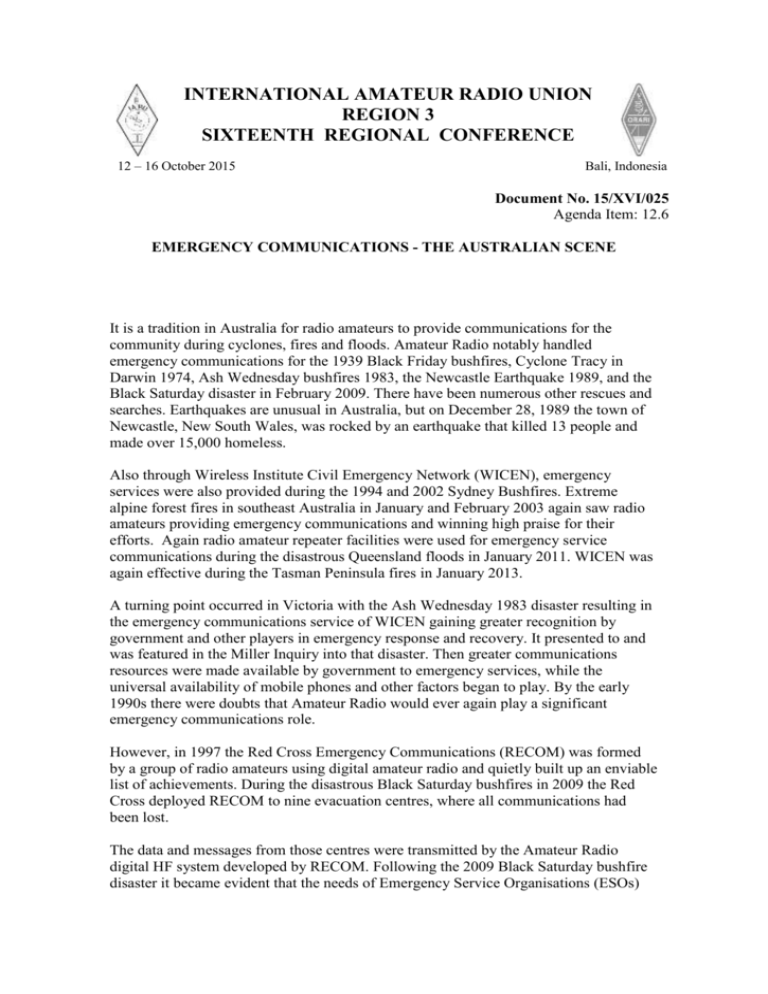
INTERNATIONAL AMATEUR RADIO UNION REGION 3 SIXTEENTH REGIONAL CONFERENCE 12 – 16 October 2015 Bali, Indonesia Document No. 15/XVI/025 Agenda Item: 12.6 EMERGENCY COMMUNICATIONS - THE AUSTRALIAN SCENE It is a tradition in Australia for radio amateurs to provide communications for the community during cyclones, fires and floods. Amateur Radio notably handled emergency communications for the 1939 Black Friday bushfires, Cyclone Tracy in Darwin 1974, Ash Wednesday bushfires 1983, the Newcastle Earthquake 1989, and the Black Saturday disaster in February 2009. There have been numerous other rescues and searches. Earthquakes are unusual in Australia, but on December 28, 1989 the town of Newcastle, New South Wales, was rocked by an earthquake that killed 13 people and made over 15,000 homeless. Also through Wireless Institute Civil Emergency Network (WICEN), emergency services were also provided during the 1994 and 2002 Sydney Bushfires. Extreme alpine forest fires in southeast Australia in January and February 2003 again saw radio amateurs providing emergency communications and winning high praise for their efforts. Again radio amateur repeater facilities were used for emergency service communications during the disastrous Queensland floods in January 2011. WICEN was again effective during the Tasman Peninsula fires in January 2013. A turning point occurred in Victoria with the Ash Wednesday 1983 disaster resulting in the emergency communications service of WICEN gaining greater recognition by government and other players in emergency response and recovery. It presented to and was featured in the Miller Inquiry into that disaster. Then greater communications resources were made available by government to emergency services, while the universal availability of mobile phones and other factors began to play. By the early 1990s there were doubts that Amateur Radio would ever again play a significant emergency communications role. However, in 1997 the Red Cross Emergency Communications (RECOM) was formed by a group of radio amateurs using digital amateur radio and quietly built up an enviable list of achievements. During the disastrous Black Saturday bushfires in 2009 the Red Cross deployed RECOM to nine evacuation centres, where all communications had been lost. The data and messages from those centres were transmitted by the Amateur Radio digital HF system developed by RECOM. Following the 2009 Black Saturday bushfire disaster it became evident that the needs of Emergency Service Organisations (ESOs) -2Document No. 15/XVI/025 and Non-Government Organisations (NGOs) had changed over the previous couple of decades. WICEN also had a role to play in Black Saturday gaining some high level recognition for its work. Coupled with the demonstrated rapid and pre-planned response of telecommunications companies to maintain or quickly restore telephone services in the bushfire affected areas, electricity supply companies also restored power within relatively short timeframes. Modern emergency communications infrastructure across Australia is now more robust and reliable, in some cases allowing seamless communications between various ESOs over the Government Radio Network. Mobile phone network coverage is also robust and extensive however these more complex systems are still vulnerable to disasters which may cut their power supplies. So there is always a need for trained and adaptable radio amateurs, sometimes providing their own equipment and skills, but also to be trained in other important counter-disaster work. They are trained and prepared for any emergency communication call that can vary among many regional WICEN groups depending on their local needs. In light of modern Government Radio communications networks, amateurs in Australia are encouraged to be prepared to assist in the time of emergencies and natural disasters. To assist amateurs the WIA has prepared a information sheet on how to prepare for emergencies. A copy of this information is attached. Conclusion Most of the time modern communications work well. Despite the development of very complex systems - or maybe because they are so complex - Amateur Radio has been called into action again and again round the world to provide communications when it really matters. Amateur Radio - A Trusted Partner in Emergency Response. Recommendation That member Societies note the contents of this paper. ____________________ -3Document No. 15/XVI/025 Prepare Yourself For Times Of Need Be Prepared Even if you don't join WICEN, you may still find yourself in the centre of an emergency. Radio Amateurs are located in all parts of the world and often find themselves at the scene of an emergency. Such was the case in the Asian tsunami where on-the-spot radio amateurs provided critical first line communications for several days until government and emergency communications systems were activated. More likely, by sheer bad luck, you will find yourself at the scene of an accident in a remote area where your cell-phone won't work. Your Amateur radio equipment may be the only form of communication, and your equipment and your radio communications skills could very likely save a life. The key to providing any effective emergency response is preparedness and it's no use finding that you, or your equipment, are not up to scratch when the time comes. There are some very simple guidelines for ensuring that you, and your equipment, are up to the job. Keep fit It's not only going to be good for your health, but emergency situations are both physically and mentally demanding. You will be much better able to deal with the stress of an extended emergency situation if you are physically fit. Know your equipment Operating in an emergency requires that you know your communication equipment and its capability to a high level of competency. You must be able to improvise, especially with antennas, and know how to quickly get a signal on-air in less than ideal circumstances. Know who to contact and what to say Having the ability to communicate is only part of the solution. You need to keep a list of emergency services contact numbers handy and be able to quickly, accurately and calmly convey the nature of the emergency and the location. This is where formal emergency training such as provided by the WIA is very helpful. Keep it in tip-top condition Radio equipment which works well in the benign environment of the home is often inadequate in emergencies. The annoying intermittent microphone cable (fixed with a wiggle) and the intermittent display (fixed with a well aimed smack on the side of the rig) become show stoppers. Fix them now before you have to rely on them. Your mobile station may need to operate in a hostile environment, so pay particular attention to the serviceability of your vehicle, its battery and its charging system, the radio equipment, the condition of the antennas, and all associated cables and connections. Have an emergency antenna and ATU handy Antennas get broken or blown down by strong winds. Keep an emergency long wire antenna handy that can be thrown over a tree, or a spare vertical whip antenna that can -4Document No. 15/XVI/025 be quickly connected. Keep a manual ATU at hand so any random length antenna can be quickly tuned. Have an emergency power source Keep fully charged batteries with sufficient capacity for at least 24 hours operation. Alternatively keep a portable generator or use the 12V power from a vehicle. Keep fuel for at least 24 hours charging. Emergency lighting Keep gaslights or other lights handy to provide at least 12 hours emergency lighting. Food, water and personal items Keep emergency food, water, medicines, clothing and toiletries.
